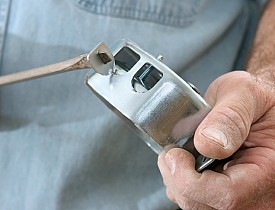Expensive Electrical Safety Violations
 The National Electrical Code is not just an encyclopedic list of suggestions for wiring and other electric components. It's the law. Most municipalities require permits for home improvement projects, including inspections by licensed electrical inspectors whenever applicable. If they find code violations, expect them to keep visiting until you are in compliance - or face potentially hefty fines.
The National Electrical Code is not just an encyclopedic list of suggestions for wiring and other electric components. It's the law. Most municipalities require permits for home improvement projects, including inspections by licensed electrical inspectors whenever applicable. If they find code violations, expect them to keep visiting until you are in compliance - or face potentially hefty fines.
The code is also a reasonable safety standard. Established by the National Fire Protection Association, code requirements all ensure a building and its components are safer. Before starting any project that might involve electric wiring, check local codes and regulations. In some areas, only a licensed electrician is allowed to do any electric work.
To be sure, all manner of electrical sins are "grandfathered in" for older homes, and the rules and fines are often less onerous for residences. A home typically only has to meet the code that was enforced at the time of construction, but a major renovation may be considered a major reason to get up to date.
Here are a few electric safety violations that could cost you money. These are general national guidelines, but some municipalities may have additional requirements:
1. Standard receptacles in bathrooms and kitchens: Codes require properly installed outlets with GFCI (ground-fault circuit interrupter) protection for all bathroom outlets and most kitchen locations. These devices break the circuit if there is a difference in flow between the line and ground current, and are crucial near water for avoiding electrocution.
2. Inappropriate outdoor receptacles: Likewise, outdoor outlets must have GFCI protection as well as waterproof boxes and covers, and they must be at least one foot off the ground.
3. Ungrounded three-prong outlets: Many older homes have ungrounded switches and outlets, but most of our new appliances have grounded three-prong plugs. The easy (and typically illegal) solution in a "grandfathered" ungrounded house is to replace an old ungrounded two-prong outlet with a new ungrounded three-prong outlet. However, this is a code violation and a good way to destroy expensive gadgets. It is also a code violation to put metal cover plates on ungrounded outlets. The plate could become electrified.
4. Wrong-sized wires: If you aren't sure what gauge of wire to use on a given circuit, you probably should leave the job to a professional. Using the wrong sized wire can be dangerous.
5. Wires too close to the edge of framing: Wires must be at least 1.25 inches away from the edge of wood framing to keep you from driving nails and drywall screws into the wire. If wires have to be run closer to the edge, they must be protected with a metal nail plate on the framing member.
6. Insulation too close to recessed lights: Recessed lights are very popular, and most homeowners want to insulate and weatherize their homes. It's a dangerous combination. Either replace recessed fixtures with more expensive models that are Insulation-Contact (IC) rated or make sure to leave the required three inches of space between lights and insulation.
These are just a few of the many electrical safety violations that could cost you money -- and possibly your house -- in the event of a fire. Consult with local officials and professional experts before starting electrical projects.
Updated July 22, 2018.
Looking for a Pro? Call us (866) 441-6648

Electrical Average Costs
Electricians Experiences

Pool Wiring Repair Eliminates A Potential Hazard

Restaurant Ceiling Fan Installation To Beat The Florida Heat



